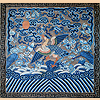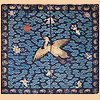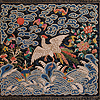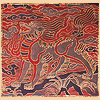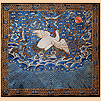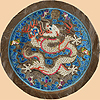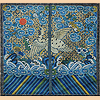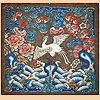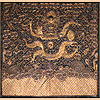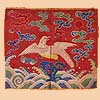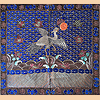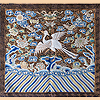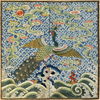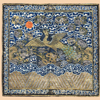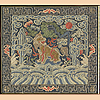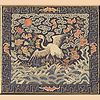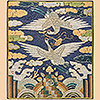
4076
Antique Korean Silk Embroidery Rank Badge
Joseon Dynasty
(1393-1897)
Circa 1800
Depicting two cranes contending a sprig of immortal fungus, among colored clouds over waves and colorful stylized rock work, a Hangul character lower left, on a figured silk mount, framed and glazed.
Size 8 1/4 x 7 1/8 in
frame 17 1/4 x 12 1/2 in
Top & Below are Detail Images
In 1454, the court of the Joseon dynasty (1392–1910) adopted a system of insignia of rank for civil and military officials based on that of China's Ming dynasty (1368–1644). Square badges of embroidered birds and animals on silk were worn on the front (hyung) and back (bae) of official costumes. They are clearly differentiated from the round badges embroidered with a dragon (called bo) worn by the king and the crown prince on the front, back, and shoulders of their court attire. Besides being ornamental, rank badges served as visible status markers in a society that prized strict social and political hierarchy. Initially permitted for wear by civil and military officials of the third rank and higher, eventually the use of rank badges was broadened to all nine ranks. Regulations on the specific animal imagery and correlating ranks evolved over the course of the Joseon dynasty. Rank badges with a pair of cranes were usually reserved for civil officials of the first to third rank. The system of hyungbae was suspended in 1899.
Asian
Textile History

